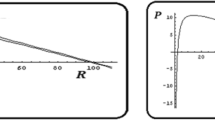Abstract.
We analyse here the equilibria of an infinite system of partial differential equations modelling the dynamics of a population infected by macroparasites. We find that it is possible to define a reproduction number R0 that satisfies the intuitive definition, and yields a sharp threshold in the behaviour of the system: if R0 < 1, the parasite-free equilibrium (PFE) is asymptotically stable and there are no endemic equilibria; if R0 > 1, the PFE is unstable and there exists a unique endemic equilibrium. The results mainly confirm what had been obtained in simplified models, except for the fact that no backward bifurcation occurs in this model. The stability of equilibria is established by extending an abstract linearization principle and by analysing the spectra of appropriate operators.
Similar content being viewed by others
References
Anderson, R.M., May, R.M.: Regulation and stability of host-parasite populations interactions 1-2. J. Animal Ecology 47, 219–247, 249–267 (1978)
Bailey, N.T.J.: The elements of stochastic processes with applications to the natural sciences. Reprint of the 1964 original. Wiley, New York, 1990
Butzer, P.L., Berens, H.: Semigroups of operators and approximation. Grund. d. math. Wiss., 145, Springer-Verlag, Berlin-Heidelberg-New York, 1967
Desch, W., Schappacher, W.: On relatively bounded perturbations of linear C0-semigroups. Ann. Scuola Norm. Sup. Pisa 11, 327–341 (1984)
Desch, W., Schappacher, W.: Linearized stability for nonlinear semigroups. In: Differential equations in Banach spaces (Bologna, 1985), A. Favini, E. Obrecht, (eds.), Lecture Notes in Math., 1223, Springer, Berlin-New York, 1986, pp. 61–73
Desch, W., Schappacher, W.: A note on the comparison of C0-semigroups. Semigroup Forum 35, 227–234 (1987)
Desch, W., Schappacher, W.: Some generation results for perturbed semigroups. In: Semigroup theory and applications (Trieste, 1987), P. Clément, S. Invernizzi, E. Mitidieri, I.I. Vrabie, (eds.), Lecture Notes in Pure and Appl. Math., 116 Dekker, New York, 1989, pp. 125–152
Desch, W., Schappacher, W., Zhang, K.P.: Semilinear evolution equations. Houston J. Math. 15, 527–552 (1989)
Diekmann, O., Heesterbeek, J.A.P., Metz, J.A.J.: On the definition and the computation of the basic reproduction ratio R0 in models for infectious diseases in heterogeneous populations. J. Math. Biol. 28, 365–382 (1990)
Diekmann, O., Kretzschmar, M.: Patterns in the effects of infectious diseases on population growth. J. Math. Biol. 29, 539–570 (1991)
Engel, K., Nagel, R.: One-parameter semigroups for linear evolution equations. With contributions by S. Brendle, M. Campiti, T. Hahn, G. Metafune, G. Nickel, D. Pallara, C. Perazzoli, A. Rhandi, S. Romanelli and R. Schnaubelt. Graduate Texts in Mathematics, 194, Springer-Verlag, New York, 2000
Hadeler, K.P., Dietz, K.: Nonlinear hyperbolic partial differential equations for the dynamics of parasite populations. Hyperbolic partial differential equations. Comput. Math. Appl. 9 (3), 415–430 (1983)
Hadeler, K.P., Dietz, K.: Population dynamics of killing parasites which reproduce in the host. J. Math. Biol. 21, 45–65 (1984)
Hudson, P.J., Rizzoli, A., Grenfell, B.T., Heesterbeek, H., Dobson, A.P. (eds), Ecology of Wildlife Diseases, Oxford University Press, Oxford, 2002
Iannelli, M.: Mathematical theory of age-structured population dynamics. Applied Math. Monographs del CNR, 7, Giardini Ed., Pisa, 1995
Isham, V.: Stochastic models of host-macroparasite interaction. Ann. Appl. Probab. 5, 720–740 (1995)
Kostizin, V.A.: Symbiose, parasitisme et évolution (étude mathématique). Hermann, Paris, (1934). Translated in The Golden Age of Theoretical Ecology, F. Scudo and J. Ziegler (eds), Lecture Notes in Biomathematics, Vol. 22, Springer-Verlag, Berlin, 1978, pp. 369–408
Kretzschmar, M.: A renewal equation with a birth-death process as a model for parasitic infections. J. Math. Biol. 27, 191–221 (1989)
Kretzschmar, M.: Comparison of an infinite dimensional model for parasitic diseases with a related 2-dimensional system. J. Math. Anal. Appl. 176, 235–260 (1993)
Kretzschmar, M., Adler, F.R.: Aggregated distributions in models for patchy populations. Theoret. Pop. Biol. 43, 1–30 (1993)
Pugliese, A.: Coexistence of macroparasites without direct interactions. Theor. Pop. Biol. 57, 145–165 (2000)
Pugliese, A., Rosà, R.: A 2-dimensional model for macroparasitic infections in a host with logistic growth, J. Biol. Syst. 3, 833–849 (1995)
Pugliese, A., Rosà, R., Damaggio, M.L.: Analysis of a model for macroparasitic infection with variable aggregation and clumped infections. J. Math. Biol. 36, 419–447 (1998)
Pugliese, A., Tonetto, L.: Well-posedness of an infinite system of partial differential equations modelling parasitic infection in an age-structured host. J. Math. Anal. Appl. 284, 144–164 (2003)
Roberts, M.G., Grenfell, B.T.: Mathematical models for macroparasites of wildlife. In: Ecology of Infectious Diseases in Natural Populations, B.T. Grenfell and A.P. Dobson (eds), Cambridge Univ. Press 1995, pp. 178–208
Rosà, R., Pugliese, A.: Aggregation, stability and oscillations in different models for host-macroparasite interactions, Theor. Pop. Biol. 61, 319–334 (2002)
Webb, G.F.: Theory of nonlinear age-dependent population dynamics. Pure and applied Mathematics, Marcel Dekker, New York-Basel, 1985
Webb, G.F.: A semigroup proof of the Sharpe-Lotka theorem. In: Infinite-dimensional systems, F. Kappel and W. Schappacher (eds), Lecture Notes in Mathematics, Vol. 1076 Springer-Verlag, Berlin, 1984, pp. 254–268
Author information
Authors and Affiliations
Corresponding author
Additional information
Revised version: 14 November 2003
Supported in part by CNR under Grant n. 00.0142.ST74 “Metodi e modelli matematici nello studio dei fenomeni biologici”
Rights and permissions
About this article
Cite this article
Pugliese, A., Tonetto, L. Thresholds for macroparasite infections. J. Math. Biol. 49, 83–110 (2004). https://doi.org/10.1007/s00285-004-0266-6
Received:
Published:
Issue Date:
DOI: https://doi.org/10.1007/s00285-004-0266-6




